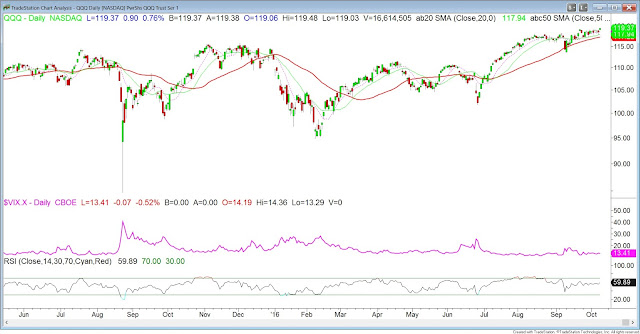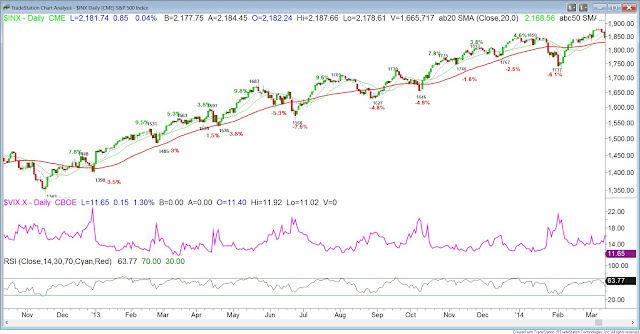As we noted in our last last post, the post-Trump rally has been accompanied by a huge thrust
in breadth. The signals we noted in that
post suggested that the recent action was indicative of some notably bullish
outcomes looking out 3-6 months and beyond.
If we considered just the stats, it was a screaming buy signal.
Yet, given the environment and market action of the last two
years, many investors have felt a bit gun-shy (perhaps, rightfully so) to step
in and buy here. Not only have they been
humbled by a choppy, mean-reverting market since late 2014, they’ve also been
forced to consider the ramifications of the likely Fed rate hike that we’ll be
seeing in a few days. Is it fully priced
in? What’s the reaction going into
year-end? Are we moving from a QE induced bull market into an earnings driven bull market as analysts like Raymond James' Jeff Saut has been proclaiming for some time now?
"Students of stock market history will recall
secular bull markets tend to have three legs. If Mr. Tuey is correct, we are
barely into the second leg of this bull market, which as previously stated, he
thinks is going to be, “The longest and strongest leg of all.” Of course that
“foots” with our thinking that there is at least another seven to eight years
left in this secular bull market. In fact, Tom Lee, sagacious captain of
FundStrat, recently published a chart showing the potential for this “bull” to
extend into the 2029-2034 timeframe. That seems a touch long to us, but heck,
if that’s what the markets give us, we will certainly take it! I did find
Tuey’s closing comments, in Gary Lamphier’s article, intriguing: “The second
key point is that for the past 100 years or more, the more severe the economic
downturn, the more powerful and enduring is the subsequent bull market. When
you’re faced with financial Armageddon as the U.S. was back in 2008, the Fed
eases much more aggressively than ever before, and they stay accommodative for
much longer than normal.”
To be sure, all of this fits with our thesis
the equity markets are transitioning from an interest rate-driven to an
earnings-driven secular bull market. To that point, many of y’all know we are
on an email “string” with folks like Arthur Cashin, David Kotok, Dennis
Gartman, Bob Pisani, etc. It is a freewheeling exchange of thoughts that
provides very interesting insights. Last Thursday, the savvy Bob Pisani wrote
this:
President-elect Trump's proposed nominee for
U.S. Treasury Secretary, Steven Mnuchin, said on our air yesterday that the
administration was still targeting a reduction in the corporate tax rate from
35% to 15%. The current 2017 estimate for the entire S&P 500 is roughly
$131 per share. Thompson estimates that every 1 percentage point reduction in
the corporate tax rate could "hypothetically" add $1.31 to 2017
earnings. So do the math: if there is a full 20 percentage point reduction in
the tax rate (from 35% to 15%), that's $1.31 x 20 = $26.20. That implies an
increase in earnings of close to 20%, or $157. What does that mean for stock
prices? The S&P is currently trading at a multiple (PE ratio) of 17, high
by historical standards. Applying that 17 multiple to earnings of $157, we get
a price on the S&P 500 of roughly 2,669 for 2017. That is 469 points or
roughly 20% above where it is today.
Our sense is the new administration will not
be able to get the corporate tax rate down to 15%, but even at a 25% rate, it
implies an additional $13.10 to the S&P 500’s bottom up operating earnings
number ($1.31 x 10 = $13.10). Using Bob’s same math produces an earnings
estimate of $144.10, and at 17 times earnings, it renders a price objective of
roughly 2450 for the S&P 500.
The equity markets have rallied hard on the
belief in a pro-growth administration, reduced regulation, lower taxes,
increased infrastructure spending, a reset on trade toward the benefit of
American companies, and the reflation trade. If this optimistic scenario comes
to fruition, the Penn-Wharton Budget Model targets between a 1.1% and 1.7%
increase in GDP growth beginning in 2018. If true, GDP growth could ramp to
~3%+, suggesting stocks are not all that expensive. Verily, we have never
wavered on the belief that we remain in a secular bull market. Such bull
markets typically last for 14-15 years and tend to compound at around 16% per
year. If past is prelude, we should have another seven-plus years in this “bull
run.” Will there be pullbacks? Of course there will be, but pullbacks should be
viewed within the construct of a secular bull market."
For those that have mustered the courage to aggressively buy
this rally, they’ve also been afforded some ripe opportunity to outperform
through stock-picking. We track the
daily correlation of the underlying S&P sectors and our data shows the
measure falling to its lowest level since August and before that late-2014. Taken a step further, the data is also borne out by the clear divergence in performance for said sectors. Being positioned in financials, energy, industrial, and materials has well outperformed laggards like utilities, consumer staples, technology, and health care over the last month.
Also favoring the bulls, was yesterday's major push higher in the number of stocks on the NYSE making new 52-week highs. The tally was the highest reading since 2013 and according to Nautilus Research it marks a significant technical feat and confirmation that bullish conditions are afoot. Their findings show that when the S&P 500 makes a new high and is accompanied by a new high in the 52-week individual stock reading (as happened yesterday), the market continues higher. Going back to 1990, this setup has occurred 16 times and in every instance the S&P has been higher one year later by an average of nearly 15%.
We are aware that this market is now overbought on multiple short-term conditions. Also in the last few years the above indicator has been a good tell for potential short term tops and bottoms. So if nothing has changed and we're still in the same environment of the last two years, then we could be closing in on a near-term top.
However if we are entering a new market environment in which a trend can be sustained ala 2013, we can be confident in sticking with the trend and going in search of bigger profits. If this is the case, and we are entering an earnings driven market the argument for active management could be coming back into vogue.












































